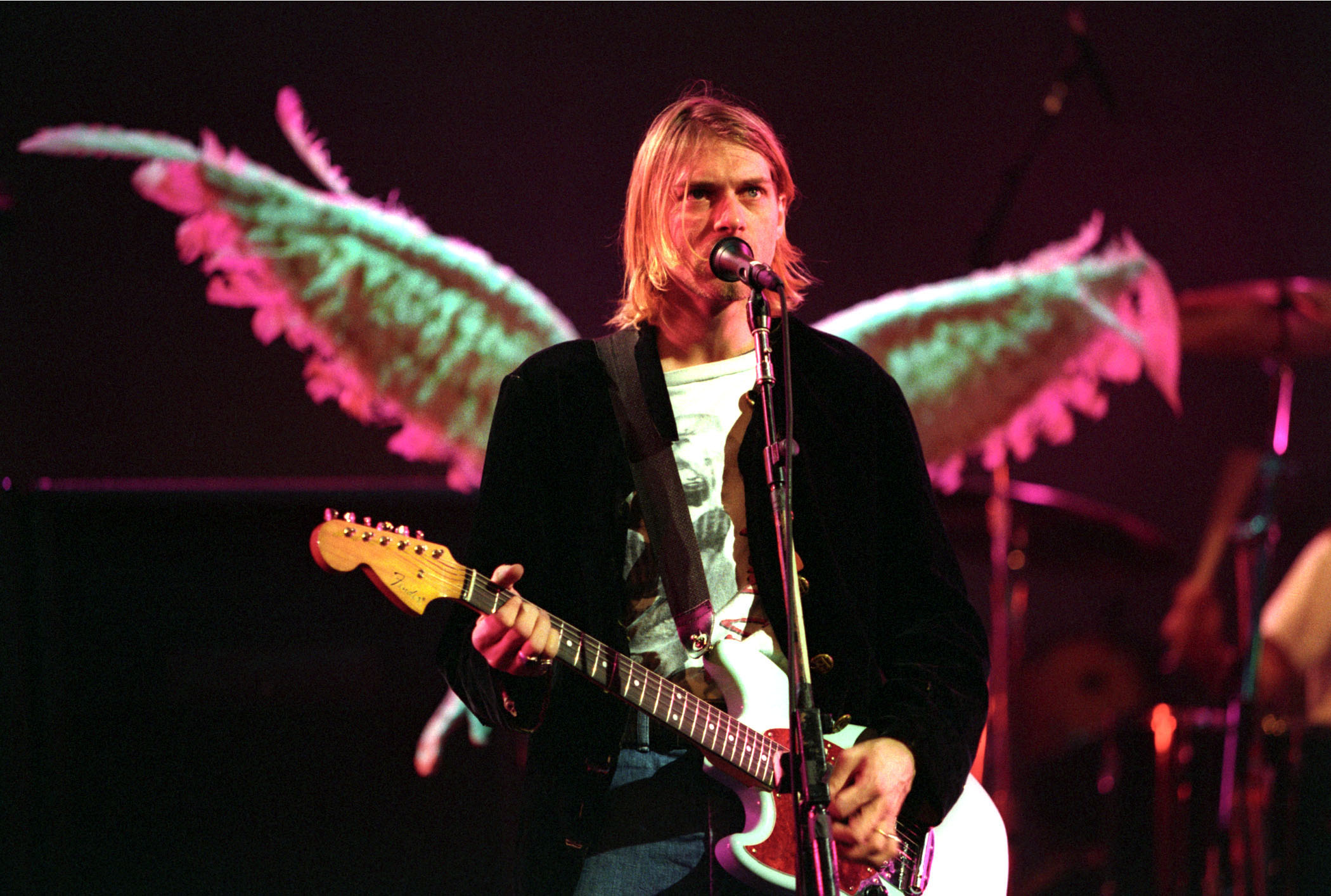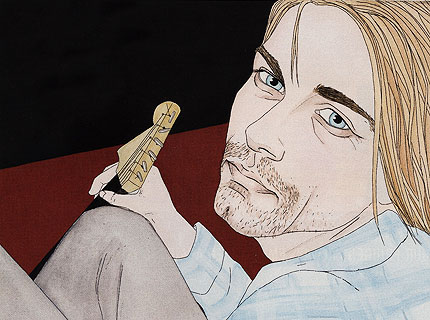In SPIN’s April 2004 tribute issue to Kurt Cobain, then senior writer Chuck Klosterman posed a compelling and unique question: “What would have happened if Cobain lived?” Below, read Klosterman’s theory about what the rock god’s future could have held, had he not died in 1994.
April 5, 1994: Kurt Cobain is admitted to the University of Washington Medical Center after surviving a massive heroin overdose. Discovered in a coma by private investigator Tom Grant, Cobain’s near-lifeless body lay alongside a loaded shotgun and (what appeared to be) a suicide note. When Cobain regains consciousness four days later, he says that the gun was “for protection” and that the letter was “personal.” He is released from the hospital after nine days of observation.
June 1, 1994: Geffen Records faxes a press release stating “Nirvana are not breaking up, but going on hiatus.” In an interview with Goldmine, bassist Krist Novoselic claims to be working on a politically charged solo album. Dave Grohl tells MTV News that he is unsure of his immediate future but hopes to work with Mercyful Fate frontman King Diamond. Cobain gives no interviews.
August 20, 1994: Cobain files for divorce from his wife of two and a half years, Courtney Love.

Also Read
Kurt Cobain Forever
October 31, 1994: The Atlanta Constitution reports that Cobain has begun work on Kurdt Kobain, a solo project written with (and produced by) R.E.M. vocalist Michael Stipe. There are conflicting reports on what the album will sound like. Cobain initially says the record will be entirely acoustic, but 20 minutes later in the same interview, he suggests that the songs will be similar to Chicago art-punk band Shellac’s recently released At Action Park.
January 15, 1995: Work on Kurdt Kobain grinds to a halt, presumably due to the growing complexity of the Cobain-Love divorce proceedings. Love publicly attacks Cobain and claims to have written “most of the fucking lyrics on In Utero.” Cobain does not respond.
March 12, 1995: The U.K.’s New Musical Express reports that demos of Kurdt Kobain sound like Oasis and that Kurdt Kobain will be the greatest solo record in rock history. It is later discovered that Kurdt Kobain demos do not exist.
June 1, 1995: Encouraged by Cobain’s attempts at rehabilitation, an Olympia, Washington, judge decrees that the singer is “more, you know, together” than Love, granting Cobain primary custody of daughter Frances Bean.
December 24, 1995: A semiconscious Cobain is revived from the front seat of his car, which is discovered running inside a sealed garage. He later says that he fell asleep after an extremely long drive from Missoula, Montana, after seeing the band Codeine.
April 1, 1996: Kurdt Kobain is released to massive critical adoration and lukewarm sales. In an interview with SPIN‘s Charles Aaron, Cobain calls the gentle, emotive album “not bad, but certainly not as good as any Vaselines record.” He also implies that Nirvana will never reunite.
May 20, 1996: Cobain scraps a scheduled 18-city club tour just two days before the opening show at First Avenue in Minneapolis.
September 13, 1996: A disguised Cobain serves as the uncredited tour guitarist for three Jesus Lizard concerts before being “outed” by Jim DeRogatis in the Chicago Sun-Times.
January 20, 1997: A Page Six item in the New York Post claims that Cobain in romantically linked to PJ Harvey.
May 14, 1997: Cobain performs a stunning acoustic version of “You Know You’re Right” on Late Night With Conan O’Brien. It is the last time he appears in public for almost two years (though, during this period, he appears on the cover of Spin twice).
October 31, 1997: Someone — presumably Cobain, possibly Dave Grohl — uploads every song off Hole’s Live Through This onto the internet. These bootleg versions feature Cobain singing lead vocals (and several tracks conclude with him telling other people in the studio how to play the chord progressions).
April 11, 1998: Strong rumors begin to circulate that a disguised Cobain was spotted holding hands with Courtney Love at a Radiohead concert in Chicago.
April 18, 1999: A Nirvana reunion is billed as the headline act for the upcoming Woodstock ’99 festival. Cobain emerges from hiding to deny this report, electing to speak with Charlie Rose on PBS. What follows is an excerpt from the broadcast conversation.
ROSE: “So… Nirvana.”
COBAIN: [Silence]
ROSE: “Influential?”
COBAIN: [Nervous laughter]
ROSE: “But then the solo record — a masterwork, arguably — but different, most certainly. A new direction. Is this where you want to go? Or is this merely where you have been? Culturally, socially, there is so much there — depth, absolutely — yet the album is sparse. Intentional? Accidental? Are we to read something deeper into this simplicity, or should we simply listen to what there is and not concern ourselves with what is not?”
COBAIN: [Long pause] “I guess.”
November 15, 1999: Cobain begins work on a second solo album that he promises will be “pure power pop, sort of like Cheap Trick.”
May 5, 2000: Kill Rock Stars releases Cobain’s Christodomy, a two-song, 74-minute album of grinding, incomprehensible noise rock. It is released exclusively on vinyl, and the lyric sheet includes only three words: betrayal, marijuana, and collapse.
November 30, 2000: Cobain is taken to the emergency room after swallowing eight ounces of hemlock, which he attributes to “a mistake caused by dehydration.”
January 18, 2001: Cobain verbally agrees to produce the soundtrack to the upcoming Todd Solondz film, Storytelling. He later drops out of the project, citing “depression.”
September 10, 2001: Kurt Cobain discusses the possibility of a Nirvana reunion with Terry Gross on National Public Radio’s Fresh Air. This is a huge story.
October 20, 2001: Nirvana re-form to play “All Apologies” during the Concert for New York City. Their performance is widely described as “breathtaking.”
December 31, 2001: Nirvana turn down a $40 million offer to stage an American stadium tour. Later, Cobain claims the band could potentially play together in the future, but only as the opening act for a Pixies reunion.
June 5, 2002: Cobain officially retires from music, stating that he intends to pursue a career in painting.
February 14, 2003: Cobain’s first 12 paintings go to auction in Seattle. One work — a morbid expressionistic collage called American Minotaur — sells for $1.2 million.
November 15, 2003: In a private Las Vegas ceremony, Cobain remarries Courtney Love.
November 16, 2003: Love goes completely nuts. The universe is at peace.




